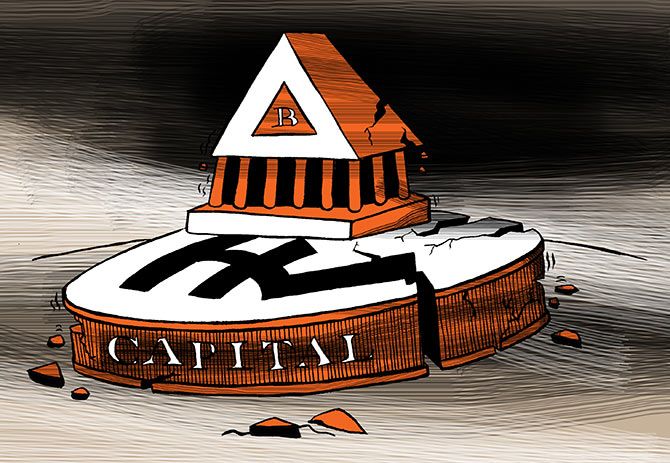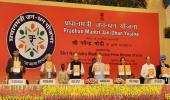None of the four benchmarks suggested by the RBI is ideal as banks in India create loan assets from their deposits and not borrowings from the regulator or the market, says Tamal Bandyopadhyay.
Illustration: Uttam Ghosh/Rediff.com

Come April, banks in India will have to link their floating rate retail loans and loans to micro and small enterprises to one of the four benchmarks -- Reserve Bank of India’s (RBI) repo rate, the 91-day and 182-day treasury bills, any other benchmark market interest rate including overnight Mumbai interbank outright rate (Mibor), based on overnight call money rates, and even term Mibor with tenures of 14-day, one month and three months.
This will ring the death knell for MCLR or the marginal cost of fund-based lending rate, at least partially (it will continue to be used for other loans).
Once the new benchmark is in place, banks will not be allowed to change the spread over the benchmark rate unless the risk perception about a borrower changes.
Spread, in this case, is the cushion that the bank enjoys over the benchmark to take care of operational costs and profitability.
The regulator wants the new system for greater transparency but most banks are upset.
In fact, the national bankers’ lobby Indian Banks’ Association had written to the RBI for continuing with the MCLR system as none of the external benchmarks has any relation to banks’ funding costs.
(Only Citibank has seen merit in this; it had linked its home loan interest rates to three-month treasury bill in March 2018.)
It seems the norm on keeping the spread unchanged through the life of a loan has upset the banks more than the external benchmark.
Historically, most banks have been abusing the system by fine-tuning the spread; they cut their MCLR but jack up the spread on loans without any provocation to protect profitability.
An internal study, based on which the RBI is introducing the new system, tore apart commercial banks for their non-transparency in fixing loan rates.
In the 1990s, banks in India started disclosing their prime lending rates (PLRs) - the interest rate charged for the most creditworthy borrowers.
In 2003, a benchmark-PLR, or BPLR, was introduced below which no bank should lend money.
As a few lending rates continued to be mandated and linked to BPLR, banks preferred to keep the BPLR at an artificially high level and charge most of their borrowers a rate below it.
In 2010, the BPLR gave way to the base rate -- the minimum rate for any loan.
The banks were to charge the borrowers a spread over this rate, depending on the borrower’s risk profile.
The cost of funds, overheads, the so-called negative carry on cash reserve ratio or CRR (on which banks don’t earn any interest), and the level of bad loans (here too, no interest is earned) were considered to arrive at the base rate.
There was no cap on the spread between the base rate and the actual loan as long as the banks could justify the spread.
In the MCLR system, introduced in 2016, the formula for computing has been the marginal cost, or the rate offered on new deposits plus the negative carry on CRR, operating cost and a tenure premium for the risk associated.
The interest rate transmission on fresh loans has been better in the MCLR regime but not on outstanding loans as when the interest rate goes down, banks woo new customers with lower rates, but tend to deny the benefit to existing customers.
Also, they are fast in raising loan rates when monetary policy is tightened but slow during the easing phase.
The RBI study found that the banks “manipulated” the methodologies for calculating the base rate and the MCLR to “inflate" the base rate or prevent it from falling in line with the cost of funds.
There has also been a lack of transparency besides “arbitrariness" in the way the banks change the spreads to offset the impact of a reduction in MCLR on their interest income.
What should be the new benchmark?
Frankly, none of the four suggested by the RBI is ideal as banks in India create loan assets from their deposits and not borrowing from the regulator or market.
Indeed, they can borrow from the RBI’s repo window but the amount is capped just at a quarter percentage of their net demand and time liability, a loose proxy for deposits.
Their cost of funds is also not dependent on the treasury bill yields which is linked to liquidity in the system and the government borrowing through this short-term route, including the so-called cash management bills.
Also, Mibor does not have the credibility of Libor or London interbank offered rate, based on the rates at which banks lend unsecured funds to each other on the London interbank market. (It’s another matter that even Libor could be rigged.)
The bank rate (or, even the marginal standing facility rate) -- the rate at which banks borrow from the RBI (now, a quarter percentage point higher than the repo rate) -- could be a better benchmark as banks can borrow far higher from this window than repo (to the extent of excess SLR securities held by them and also dip into the SLR stipulation up to 2 per cent of their deposits).
While banks in India have shifted to floating-rate loans, there aren’t too many takers for floating rate deposits.
The inflation-indexed bonds are also not selling well.
The government’s small savings schemes with higher rate and tax benefits (theoretically, here the rates are to be reset every quarter but that doesn’t always happen) as well as mutual funds, which also offer tax benefits, do not encourage savers to buy the floating rate deposit bait.
The right benchmark for bank loans is still a chimera (it’s a quarter century since the RBI deregulated loan rates in 1994) but a vigil on the spread is critical.
Also, let all loans be linked to a benchmark.
The developed markets typically have two benchmark rates - one for retail loans and another for corporate loans.
For instance, in the US, the prime rate -- higher than the Federal Reserve rate -- is the benchmark rate for all consumer and retail loans and Libor is the reference point for all corporate loans.
The banks are not happy with RBI’s micro-management but it’s essential when even a free market doesn’t ensure competition.
The industry took long to exercise freedom after the savings bank rate was freed.
Protecting consumers’ interests is something most Indian banks are not exactly fond of.
Tamal Bandyopadhyay, a consulting editor with Business Standard, is an author and senior adviser to Jana Small Finance Bank Ltd.











